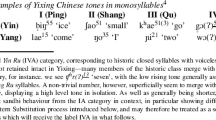Abstract
This paper distinguishes between scopal affix paradigms and compositional affix paradigms, two notions confused in the literature. The Yi languages (Tibeto-Burman: China) exhibit maximally scopal paradigms which reflect the cognitive layers of the sentence in the mind of the speaker. In spite of this prototypical pattern, the paradigm is full of noncompostional pairs of morphemes.
Similar content being viewed by others
Notes
Although McGregor (2002:25) does not discuss affix order in Ngarinyin, it follows nevertheless from the description that the paradigm of the classificatory verb is largely templatic.
For the interlinear glosses, see the list of abbrevations at the end of the paper. Glosses of verb enclitics in the Yi languages are separately presented in Table 4.
There are for example three types of aspects: phasal aspect (inchoative, completive), viewpoint aspect (perfective, imperfective), quantificational aspect (experiental, habitual). Quantifcational aspect seems to be as relevant to the verb as tense.
Generative models such as lexicalism (Chomsky 1970; Anderson 1992) and distributed morphology (Halle and Marantz 1993) do not provide a systemic integration of affix concepts. Wunderlich and Fabri (1995:246–247) propose a hierarchy of functional categories that is similar to Bybee’s. It is conceived as a component of the generative theory of word formation and empirically justified only with German data. Formal semantic approaches such as Davidsonian event semantics or Montegovian possible world semantics analyze affix concepts individually not in a system. (Davidsonian event semantics models aspectual notions, while Montegovian possible world semantics formalizes modality.) Cinque (1999) proposes classes of “lower” and “higher” adverbial phrases but his conclusions are derived from adverbial phrases not affixes.
References
Allen, M. R. (1978). Morphological investigations. PhD dissertation, University of Connecticut.
Anderson, S. (1992). A-morphous morphology. Cambridge: Cambridge University Press.
Bybee, J. (1985). Morphology: a study of the relation between meaning and form. Amsterdam: Benjamins.
Bühler, K. (2011). Theory of language (Translation of Sprachtheorie). Amsterdam: Benjamins. [1934]
Chomsky, N. (1970). Remarks on nominalization. In R. Jacobs & P. Rosenbaum (Eds.), Reading in English transformational grammar. Waltham: Blaisdell.
Cinque, G. (1999). Adverbs and functional heads: a cross-linguistic perspective. Oxford: Oxford University Press.
Comrie, B. (1989). Language universals and linguistics typology (2nd ed.). Chicago: University of Chicago Press.
Dik, S., & Hengeveld, K. (1997). In H. Kees (Ed.), The theory of functional grammar, Part 1. The structure of the clause. Berlin: Mouton de Gruyter.
Frege, G. (1884). Die Grundlagen der Arithmetik: Eine logisch-mathematische Untersuchung über den Begriff der Zahl. Hildesheim: Koebner. Reprint published by Georg Olms, Hildesheim, 1961.
McGregor, W. (2002). Verb classification in Australian languages. Berlin: Mouton de Gruyter.
Gerner, M. (2002a). Predicate compounding in the Yi group: the continuum of grammaticalization. Berlin: Akademie Verlag.
Gerner, M. (2002b). Perfect in Yi group: stative and dynamic information management. Studies in Language, 26(2), 337–368.
Gerner, M. (2004). Occurrence particles in the Yi group and their interaction with the occurrence type of a situation. Lingua, 114(11), 1331–1366.
Gerner, M. (2007). The exhaustion particles in the Yi group: a unified approach to all, the completive and the superlative. Journal of Semantics, 24(1), 27–72.
Gerner, M. (2009). Assessing the modality particles of the Yi group in fuzzy possible-worlds semantics. Linguistics and Philosophy, 32(2), 143–184.
Gerner, M. (2013). Yi future: tense or evidential? Language and Linguistics, 14(1), 167–192.
Haiman, J. (1983). Iconomic and economic motivation. Language, 59, 781–819.
Halle, M., & Marantz, A. (1993). Distributed morphology and the pieces of inflection. In K. Hale & S. J. Keyser (Eds.), The view from building 20 (pp. 111–176). Cambridge: MIT Press.
Halliday, M. (1970). Functional diversity in language. Foundation of Language, 6, 322–361.
Hengeveld, K. (1989). Layers and operators in functional grammar. Journal of Linguistcs, 25, 127–157.
Hyman, L. (2003). Suffix ordering in Bantu: a morphocentric approach. In G. Booij & J. van Marle (Eds.), Yearbook of morphology (pp. 245–281). Dordrecht: Kluwer.
Inkelas, S. (1993). Nimboran position class morphology. Natural Language & Linguistic Theory, 11, 559–624.
Jackendoff, R. S. (1977). X-bar syntax: a study of phrase structure. Cambridge: MIT Press.
Janssen, T. M. V. (1997). Compositionality. In J. van Benthem & A. ter Meulen (Eds.), Handbook of logic and language (pp. 417–473). Amsterdam: Elsevier.
Korotkova, N., & Lander, Y. (2010). Deriving ordering in polysynthesis: evidence from Adyghe. Morphology, 20, 299–319.
Manova, S., & Aronoff, M. (2010). Modeling affix order. Morphology, 20, 109–131.
Matisoff, J. (1989). Tone, intonation, and sound symbolism in Lahu: loading the syllable canon. Linguistics of the Tibeto-Burman Area, 12(2), 147–164.
Mithun, M. (1999). The languages of native North America. Cambridge: Cambridge University Press.
Morwood, J. (2001). Oxford grammar of classical Greek. Oxford: Oxford University Press.
Nordlinger, R. (2010). Verbal morphology in Murrinh-Patha: evidence for templates. Morphology, 20, 321–341.
Pulleyblank, E. G. (1995). Outline of classical Chinese grammar. Vancouver: UBC Press.
Rice, K. (2000). Morpheme order and semantic scope. Cambridge: Cambridge University Press.
Simpson, J., & Withgott, M. (1986). Pronominal clitic clusters and templates. In H. Bohrer (Ed.), The syntax of pronominal clitics. Syntax and semantics (pp. 149–174). New York: Academic Press.
Spencer, A. (1991). Morphological theory. Oxford: Oxford University Press.
Stump, G. T. (1997). Template morphology and inflectional morphology. In G. Booij & J. van Marle (Eds.), Yearbook of morphology 1996 (pp. 217–241). Dordrecht: Kluwer.
Szabó, Z. G. (2012). Compositionality. In E. Zalta (Ed.), The Stanford encyclopedia of philosophy (Winter 2012 edition). http://plato.stanford.edu/archives/win2012/entries/compositionality/.
VanValin, & LaPolla, R. (1997). Syntax. Structure, meaning and function. Cambridge: Cambridge University Press.
Whaley, L. J. (1997). Introduction to typology: the unity and diversity of language. Thousand Oaks: Sage Publications.
Wunderlich, D., & Fabri, R. (1995). Minimalist morphology: an approach to inflection. Zeitschrift für Sprachwissenschaft, 14, 236–294.
Author information
Authors and Affiliations
Corresponding author
Additional information
I wish to thank Ingo Plag, Editor of Morphology, and three anonymous reviewers for helpful comments on previous drafts. An early version of this paper was presented at the 3rd Vienna Workshop on Affix Order in Vienna (Austria), 15–16 January 2011.
Rights and permissions
About this article
Cite this article
Gerner, M. Noncompositional scopal morphology in Yi. Morphology 24, 1–24 (2014). https://doi.org/10.1007/s11525-014-9231-2
Received:
Accepted:
Published:
Issue Date:
DOI: https://doi.org/10.1007/s11525-014-9231-2




